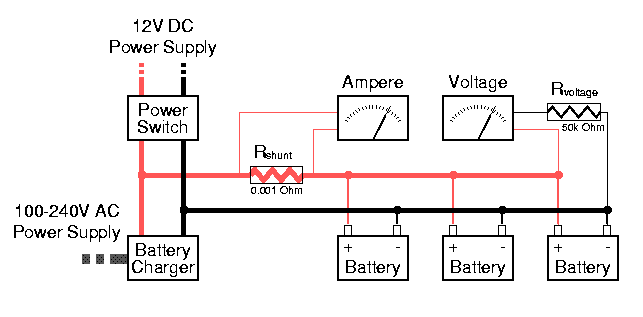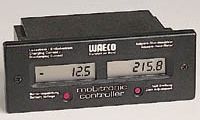Monitoring Instruments for on-board Power Supply
The electrical power supply on board of a sailing vessel is a
safety issue and should be managed the same way water and food
supplies are managed.
But contrary to other supplies, battery capacity varies considerably
with ambient temperature and with the rate at which the capacity
is consumed. This makes accurate monitoring of battery capacity
hard to achieve so that practically only a good estimate of
the available capacity can be made.
A rational energy management requires knowledge of the current power consumption, knowledge of the remaining energy stored in the batteries ("SoC") as well as supervision of the energy flow from external energy sources into the batteries. The parameters involved in the energy management of the battery supply are battery voltage, charging/discharging currents and State-of-Charge (SoC) of the battery. Monitoring Battery Voltage and Current
The following schematic diagramm shows the principal elements of a 12V on-board
power supply installation and how they are connected:
 The example shows a system with three parallel connected batteries, a shunt resistance (Rshunt) in the positive supply cable and the connection to the battery charger. To measure voltage and current two (analogue) meters are connected as shown. The supply network of the boat is connected to this power system by a power switch allowing a complete disconnection of the supply system from the electrical loads. These power switches should be selected according to the maximum expected current ratings in the supply network.
The shunt resistance in the main supply path is used to measure the current
drawn from the batteries.
Power drawn from the battery will cause a voltage drop over the
shunt resistance directly proportional to the electrical current: Ushunt = Isupply x RshuntA typical value for the shunt resistance is 0.001 Ohm. In this case a 50 A charging current will result in a voltage drop of 0.050 V. This voltage drop is measured with a sensitive Volt-Ampere meter. Since there is a linear relation between Ushunt and the current flowing through the shunt, the milli-volt meter can be directly labelled in Ampere. With a shunt of 0.001 Ohm each mV of voltage over the shunt resistor represents 1A of battery current. The range of charging currents (e.g. 50 A) down to the stand by supply current for the gas alarm (e.g. 5 mA) requires a measurement range of 1/1000 and a resolution of at least 1/10000. This means that voltages in the range of 5 microvolts will have to be measured reliably. Beware of digital instruments displaying 4 or 5 digits because measurements are not better than 1% So resolution is about 0.5 A or in capacity: 12 Ah/day!! --> non-linear A-mv conversion ??? This requires shielded (coaxial) cabling between the measurement instrument and the shunt resistor. Shunt-free current measurements: no voltage drop: complex and expensive??? Monitoring Battery Capacity
| ||||||
| Cover << Sail Away << Batteries << . | . >> Glossary | last updated: 20-Mar-2009 |

